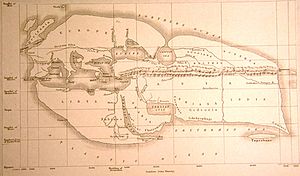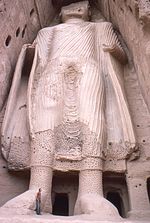- Ariana
-
This article is about a historical term. For other uses, see Ariana (disambiguation).
History of Afghanistan Timeline Bronze age and Proto-Elamite culture in Nimruz area (2300–1800 BC) Bronze age and Indus valley civilization in Mundigak (Kandahar area) (2200–1800 BC) Bronze age and Oxus civilization in northern Afghanistan (2100–1800 BC) Late Bronze age and Iron age and coming of Aryans (1700–700 BC) Median Empire (728–550 BC) Achaemenids (550–330 BC) Seleucids (330–150 BC) Mauryans (305–180 BC) Greco-Bactrians (256–125 BC) Indo-Greeks (180–130 BC) Indo-Scythians (Sakas) (155–80? BC) Indo-Parthians (20 BC–50? AD) Kushans (135 BC–248 AD) Sassanids (230–565) Indo-Sassanids (248–410) Kidarites (320–465) Hephthalites (410–557) Kabul Shahi (565–879) Rashidun Caliphate (642–641) Umayyads (661–750) Abbasids (750–821) Tahirids (821–873) Saffarids (863–900)) Samanids (875–999) Ghaznavids (963–1187) Seljukids (1037–1194) Khwarezmids (1077–1231) Ghorids (1149–1212) Ilkhanate (1258–1353) Kartids (1245–1381) Timurids (1370–1506) Arghun (1479-1522) Mughals (1501–1738) Safavids (1510–1709) Hotaki dynasty (1709–1738) Afsharids (1738–1747) Durrani Empire (1747–1826) Emirate of Afghanistan (1826–1919) Kingdom of Afghanistan (1919–1973) Republic of Afghanistan (1973–1978) Democratic Republic (1978–1992) Islamic State (1992–1996) Islamic Emirate (1996–2001) Islamic Republic (2001–) Afghan Civil War 1979–1989 1989–1992 1992–1996 1996–2001 2001–present
Ariana, the Latinized form of (Greek: ἡ 'Αρειανή/Arianē),[1][2] inhabitants: Ariani (Greek: Αρειανοί/Arianoi),[3] was a general geographical term used by some Greek and Roman authors of ancient period for a district of wide extent in Central Asia[4] next to india[5], comprehending the eastern provinces of the great Persian kingdom[6], now Afghanistan, east and southeast of Iran, Tajikistan and north of Pakistan.[7]
At various times, the region was governed by the Persians (Achaemenids, 550-330 BC; Sasanians, 275-650 AD; Kushano-Sasanians, 345-450 AD), Macedonians (Seleucids, 330-250 BC; Greco-Bactrians, 250-110 BC; Indo-Greeks, 155-90 BC), Iranians (Parthians, 160 BC-225 AD; Indo-Scythians, 90 BC-20 AD; Indo-Parthians, 20-225 AD; Kushans, 110 BC-225 AD), white Huns (Kidarites, 360-465 AD; Hephthalites, 450-565 AD), but later partly also the Indians (Mauryans, 275-185 BC; Hindu-Shahis; 870-1000 AD)[8]
Contents
Etymology of Ariana
The Greek term Arianē (Latin: Ariana) is based upon Old Iranian Āryana- (Avestan: Airiiana-, esp. in Airiianəm vaēǰō, the name of the Aryans’ mother country, whose localization is disputed).[9] The modern name Iran represents the ancient name Ariana, - a word itself of Avestan origin.[10]; a view which is borne out by the traditions of the country preserved in the Muslim writers of the ninth and tenth centuries.[11]
The names Ariana and Aria, and many other ancient titles of which Aria is a component element, are connected with the Sanskrit term Arya-, the Avestan term Airya-, and the Old Persian term Ariya- , a self designation of the peoples of Ancient India and Ancient Iran[12], meaning "noble", "excellent" and "honourable".[13]
Extent of Ariana
The exact limits of Ariana are laid down with little accuracy in classical sources, and it seems to have been often confused (as in Pliny, Naturalis Historia, book vi, chapter 23) with the small province of Aria.[14]
 The name Ariana can be seen in this 19th century reconstruction of world map by Eratosthenes, c.194 BC.
The name Ariana can be seen in this 19th century reconstruction of world map by Eratosthenes, c.194 BC.
As a geographical term, Ariana was introduced by the Greek geographer, Eratosthenes (c. 276 BC – c. 195 BC), and was fully described by the Greek geographer Strabo (64/63 BC – ca. AD 24)[15], and by the Roman author and natural philosopher, Pliny (23-79 AD), who states that it included the Arii, with other tribes.
Per Eratostene's definition, the borders of Ariana were defined by the Indus River in the east, the sea in the south, a line from Carmania to the Caspian Gates in the west, and the so-called Taurus Mountains in the north. This large region included almost all of the countries east of Media and ancient Persia, including south of the great mountain ranges up to the deserts of Gedrosia and Carmania,[16] i.e. the provinces of Carmania, Gedrosia, Drangiana, Arachosia, Aria, the Paropamisadae; also Bactria was reckoned to Ariana and was called "the ornament of Ariana as a whole" by Apollodorus of Artemita.[17]
After having described the boundaries of Ariana, Strabo writes that the name Αρειανή could also be extended to part of the Persians and the Medes and also to the northwards Bactrians and the Sogdians.[18] A detailed description of that region is to be found in Strabo's Geographica, Book XV – "Persia, Ariana, the Indian subcontinent", chapter 2, sections 1-9.
By Herodotus Ariana is not mentioned, nor is it included in the geographical description of Stephanus of Byzantium and Ptolemy, or in the narrative of Arrian.[19]
Having considered these various sources, Ariana included modern-day Afghanistan (Bactria, Aria, Drangiana, Arachosia, and the Paropamisadae), east and southeast Iran (east Media, Persia, Carmania and Gedrosia), most of Tajikistan (Sogdiana), south Turkmenistan (Margiana), south Uzbekistan (parts of Sogdiana) and extending to the Indus River in Pakistan.[20]
Inhabitants of Ariana
The tribes by whom Ariana was inhabited, as enumerated by Strabo were:[21]
- Arachoti;
- Arii;
- Bactrians;
- Drangae;
- Gedrosii;
- Paropamisadae;
- Parthians;
- east Persians;
- Sogdians.
Pliny (vi. 25) specifies the following tribes:
- Angutturi;
- Arii;
- the inhabitants of Daritis;
- Dorisci;
- Drangae;
- Evergetae;
- Gedrussi;
- Ichthyophagi;
- Methorici;
- Pasires;
- Urbi;
- Zarangae.
Pliny (vi. 23) says that some add to India four satrapies to the west of the river, - the Gedrosii, Arachosii, Arii, and Paropamisadae, as far as the river Cophes (the river Kabul). Pliny therefore agrees on the whole with Strabo. Dionysius Periegetes (1097) agrees with Strabo in extending the northern boundary of the Ariani to the Paropamisus, and (714) speaks of them as inhabiting the shores of the Erythraean Sea. It is probable, from Strabo (xv. p.724), that that geographer was included to include the east Persians, Bactrians, and Sogdians, with the people of Ariana below the mountains, because they were for the most part of one speech.[22]
Rüdiger Schmitt, the German scholar of Iranian Studies, also believes that Ariana should have included other Iranian people. He writes in the Encyclopædia Iranica:
Eratosthenes’ use of this term (followed by Diodorus 2.37.6) is obviously due to a mistake, since, firstly, not all inhabitants of these lands belonged to the same tribe and, secondly, the term "Aryan" originally was an ethnical one and only later a political one as the name of the Iranian empire (for all North Indians and Iranians designated themselves as "Aryan"; See Aryan), thus comprising still other Iranian tribes outside of Ariana proper, like Medes, Persians or Sogdians (so possibly in Diodorus 1.94.2, where Zarathushtra is said to have preached Ahura Mazdā's laws "among the Arianoi").[8]—R. Schmitt, 1986See also
- Arianus
- Avestan geography
- Āryāvarta
- Greater Khorasan
References
- ^ Sabahuddin, Abdul (2008). History of Afghanistan. Global Vision Publishing Ho. p. 15. ISBN 8182202469. http://books.google.com/books?id=XfDYtxfOvTYC&lpg=PP1&pg=PA15#v=onepage&q&f=false. Retrieved 2010-09-23.
- ^ Strabo
- ^ Pliny, Naturalis Historia, book vi., page 23
- ^ W. Smith, 1870, 'Ariana'
- ^ R. Schmitt, 1986, 'ARIA', Encyclopaedia Iranica Online
- ^ 'Ărĭāna', Charlton T. Lewis, Charles Short, A Latin Dictionary, Perseus Digital Library.
- ^ The Columbia Encyclopedia, Sixth Edition, 2008
- ^ a b Encyclopædia Iranica, ARIA (2. Ariane), by Rüdiger Schmitt. December 15, 1986.
- ^ R. Schmitt, 1986, 'ARIA', Encyclopaedia Iranica
- ^ G. Gnoli, 2006, Encyclopaedia Iranica, 'IRANIAN IDENTITY ii. PRE-ISLAMIC PERIOD'
- ^ A. Ashraf, 2006, Encyclopaedia Iranica, 'IRANIAN IDENTITY iii. MEDIEVAL ISLAMIC PERIOD'
- ^ R. Schmitt, 1987, 'ARYANS', Encyclopaedia Iranica
- ^ Dictionary of Greek and Roman geography, William Smith, 1870, pp. 210, Aria'na
- ^ Dictionary of Greek and Roman geography, William Smith, 1870, pp. 210, Aria'na http://www.archive.org/stream/dictionaryofgree01smituoft#page/210/mode/1up]
- ^ Strabo 2.1.22f
- ^ Strabo 2.5.32
- ^ Strabo 11.11.1
- ^ The "Aryan" Language, Gherardo Gnoli, Instituto Italiano per l'Africa e l'Oriente, Roma, 2002, page 86
- ^ W. Smith, 1870, 'Ariana'
- ^ The Columbia Encyclopedia, Sixth Edition, 2008
- ^ STRABO GEOGRAPHY, Book XV, Chapter 2
- ^ Dictionary of Greek and Roman geography, William Smith, 1870, pp. 210, Aria'na http://www.archive.org/stream/dictionaryofgree01smituoft#page/210/mode/1up]
Further reading
- Horace Hayman Wilson, Charles Masson, Ariana Antiqua: a Descriptive Account of the Antiquities and Coins of Afghanistan, 1841
- Henry Walter Bellew, An inquiry into the ethnography of Afghanistan, 1891
- Tomaschek in Pauly-Wissowa, II/1, cols. 619f., and 813f.
- G. Gnoli, Postilla ad Ariyō šayana, RSO 41, 1966, pp. 329–34.
- P. Calmeyer, AMI 15, 1982, pp. 135ff.
External links
- Encyclopaedia Iranica ARIA region in the eastern part of the Persian empire
- 'Ărĭāna', Charlton T. Lewis, Charles Short, A Latin Dictionary, Perseus Digital Library.
- 'ARIANA', Dictionary of Greek and Roman geography, William Smith, 1870
- 'STRABO GEOGRAPHY', Book XV, Chapter 2.
- Pliny the Elder, The Natural History, CHAP. 23. (20.)—THE INDUS., Perseus Digital Library.
- Pliny the Elder, The Natural History, CHAP. 25.—THE ARIANI AND THE ADJOINING NATIONS., Perseus Digital Library.
- POMPONIUS MELA: DE CHOROGRAPHIA LIBER PRIMUS
- Ariana antiqua: a descriptive account of the antiquities and coins of Afghanistan By Horace Hayman Wilson, Charles Masson
- Eratosthenes, Duane W. Roller, Strabo, 2010, 'Eratosthenes' Geography'
Categories:- Historiography of Afghanistan
- History of Iran
- History of Zoroastrianism
- Ancient Iranian peoples
- Eurasian nomads
- Ancient Greek geography
- Historical regions of Afghanistan
Wikimedia Foundation. 2010.

